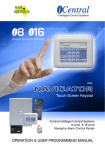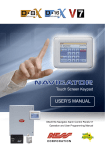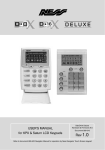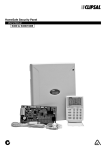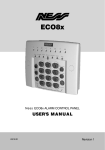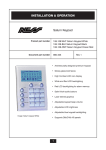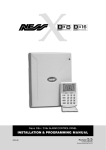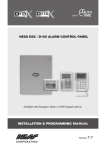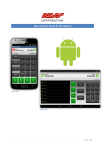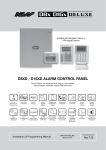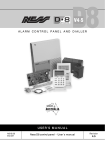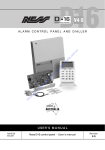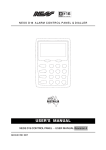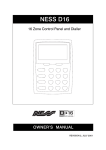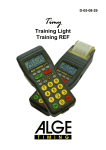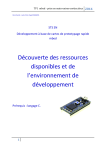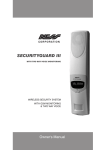Download User`s MANUAL - avic security
Transcript
NOW WITH Ness D8x / D16x alarm control panel User's MANUAL A$15.00 Revision 6.2 Head Office: Ness Security Products Pty Ltd ABN 28 069 984 372 4 / 167 Prospect Hwy Seven Hills NSW 2147 Australia Ph +61 2 8825 9222 Admin Fax +61 2 9838 8508 [email protected] www.ness.com.au SYDNEY Ph 02 8825 9222 Fax 02 9674 2520 [email protected] MELBOURNE Ph 03 9875 6400 Fax 03 9875 6422 [email protected] BRISBANE Ph 07 3399 4910 Fax 07 3217 9711 [email protected] “Australia’s largest designer and manufacturer of high quality security products” N55 PERTH Ph 08 9328 2511 Fax 08 9227 7073 [email protected] Adelaide Ph 08 8152 0000 Fax 08 8152 0100 [email protected] D8x/D16x USER Manual Rev 6.2, Nov09 Document Part Number: 890-006 WARNING ADSL NOTICE Installation and maintenance shall be performed by qualified service personnel only. ADSL broadband data can interfere with the operation of your alarm dialler. CAUTION It is recommended that a quality ADSL filter be installed as per the filter manufacturer's guidelines in all premises with an alarm dialler installed. Risk of explosion if battery is replaced by an incorrect type. Dispose of used batteries according to the instructions on the battery. Copyright Notice All rights reserved. No part of this publication may be reproduced, transmitted or stored in a retrieval system in any form or by any means, electronic, mechanical, photocopying, recording, or otherwise, without the prior written permission of Ness. Ness reserves the right to make changes to features and specifications at any time without prior notification in the interest of ongoing product development and improvement. © 2009 Ness Security Products Pty Ltd ABN 28 069 984 372 CONTENTS Features........................................................................ 4 Introduction .................................................................. 5 Keypad.......................................................................... 6 Visual Indicators............................................................ 7 Operation.............................................................. 8, 9 Arming..................................................................... 10 Disarming................................................................ 11 Home (Monitor) Mode............................................. 12 Keypad Panic........................................................... 13 Keypad Duress........................................................ 13 Keypad Fire Alarm................................................... 14 Keypad Medical Alarm............................................ 14 Excluding Zones...................................................... 15 View Memory........................................................... 16 Temporary Day Zones............................................. 17 AutoTime Features.................................................. 18 AutoTime Operation................................................ 19 PROGRAMMING......................................................... 20 Programming Options Table................................... 21 User Code programming........................................ 22 Entry/Exit Timer programming................................ 23 Telephone Number programming........................... 23 Real Time Clock programming............................... 24 Monitoring, Central station / Audible ......................... 25 Remote operation by telephone........................... 26, 27 Ness Accessories.................................................. 28, 29 Troubleshooting.......................................................... 30 Installation Record...................................................... 31 Operation Summary............................................. 32 Ness D8x and D16x Features •8 or 16 alarm zones (D8x / D16x). •Supports up to 3 remote LCD keypads. •56 user codes can be programmed to operate by keypad PIN, radio key or access card. •Optional Ness Radio Interface for fully integrated wireless security. •Programmable 2 Area partitioning can split the panel into two independent areas plus a common area. •Real Time Clock with AutoTime features Automatically arm/disarm and control auxiliary outputs on a daily or weekly basis. •3 Door Access Controller onboard with support for Weigand prox or fingerprint readers. •Home Mode allows partial arming, (eg, perimeter security overnight). •Day Mode feature allows daytime monitoring of fire doors, coolrooms etc. •Temporary Day Zone feature allows easy enabling/disabling of Day Mode. •4 programmable auxiliary outputs can be operated automatically by AutoTime or manually by keypad. •Enhanced serial data input/output via RS232. Interface with third party products. • Automatic reset fuses / no glass fuses to replace. •Programmable siren/reset lockout complies with noise regulations. •30 event memory can be reviewed by keypad. •Easy programming by keypad or NessComms™ software. •All programming data is permanently stored in a non-volatile memory. •All inputs and outputs are heavily protected against lightning and high voltage supply transients. •Optional output expander for even more auxiliary outputs. DIALLER •Keypad Panic feature. •Full remote upload/download by PC and modem using NessComms™ software. •Keypad Duress feature. •Remote control of outputs by telephone. •Two button arming feature. •Arm/disarm remotely by telephone •Fire Alarm feature with different siren tones. •Contact ID Format for central station monitoring. Supports two 14 digit phone numbers plus one “follow me” number for audible monitoring. •Highly flexible zone to output mapping. •Multiple programmable EOL resistor values from 0k to 22k. An installer's favourite. •Onboard Vibration Sensor Analyser with programmable sensitivity. Use with Nessensor™ vibration sensors. •Audible Voice reporting feature. •Phone line integrity monitoring can activate an output if the phone line is disconnected. •Dialler ‘Listen in’ option for installers. •Siren chirp and strobe flash on arming with radio key. •Auto Test calls daily, weekly or any interval. •Quiet chirps option on arm/disarm by radio key. •Pulse or DTMF dialling. •True Dynamic Battery Test actively tests the battery under load every hour. •True dial tone detection. Ness D8x / D16x Control Panel – User's Manual Introduction The Ness D8x and D16x microcomputer based 8 or 16 zone control panel is the heart of your security system to which all your detection devices connect. Each Zone of the panel can be connected to one or more detection devices to protect separate rooms of your premises. Detection devices may be wired to the panel or you can use optional wireless detectors. Passive Infra-Red motion detectors (PIRs) are used to detect motion of people or animals. Pet Aware motion detectors can ignore pets and still detect people. Reed Switches are fitted to windows and doors to detect opening. Vibration sensors such as the Nessensor™ can be used to detect glass breakage or forcing of windows or doors. Normally a zone is considered Sealed. Activation of a detection device will cause the zone to be Unsealed and may cause an alarm. Detectors such as fire detectors and panic buttons must be able to generate an alarm at all times regardless of the panel setting. A zone with this assignment is called a 24 hour zone. Some detection devices may be required to generate an alarm or warning only when the panel is Disarmed. A zone with this assignment is called a Day zone. Before leaving the premises you must "Arm" (turn on) the panel. After arming, the panel will ignore detectors during the Exit Delay Time to allow you to exit without triggering an alarm. The system can be armed and disarmed using the keypad supplied or by optional Radio Keys or Access Cards or Fobs. When you enter the premises the panel will ignore selected zones for the Entry Delay Time and will not alarm unless you disarm the panel during this allowed time. When an alarm occurs, it can be reset with a User Code1 or by optional Radio Key or Access Card/Fob2, otherwise it will reset at the end of Alarm Reset Time. Resetting an alarm stops the sirens and strobe light. If an alarm is not reset the sirens will stop after the programmed time (default is 5 minutes) and the strobe light will stop after 72 hours. Home Mode (also called Monitor mode) allows you to Arm selected zones while others are ignored. Typically, perimeter zones (doors and windows) can be monitored while you are at home. If you wish to split your alarm system into two areas with access limited to each area by code numbers then Area operation is used. Radio Keys can also Arm and Disarm Areas. The control panel housing and the covers over external sirens are protected by tamper switches to detect someone attempting to disable the security system. Activation of these switches will cause an instant tamper alarm. If there is a problem with a detector, you can Exclude the associated zone so that it is totally ign ored and cannot generate an alarm. Including the zone will enable it to generate an alarm again. The control panel is fitted with a rechargeable backup battery to ensure your security system continues to operate if the mains power is interrupted. This control panel automatically tests the battery every hour and whenever you Arm/Disarm the panel. (Dynamic Battery Test). All alarms are stored in memory and can be viewed at any time in Memory Mode. Keypad codes programmed as Arm Only will not reset the panel. 1 Access Cards/Fobs can reset the panel if the Disarm By Access Card option has been enabled by your installer. 2 Ness D8x / D16x Control Panel – User's Manual Keypad The D8x and D16x control panels are supplied with an LCD Keypad which provides important visual and audible indications and is the main interface for operating and programming the control panel. Up to three keypads can be connected to a D8x or D16x panel. Keypad Beeps Beeps Meaning Any key press. 1 BEEP 3 BEEPS –– ..10.. Valid Command. 1 LONG BEEP Error. 10 BEEPS Mains Power is off or Panel Battery is low or A Radio Device has sent a low battery signal or Telephone Line Fail has been detected. An AutoTime action is ... ... ... Constant slow beeps due to begin. . . . Constant fast beeps An AutoTime action will begin in one minute. Display TEST To display all the keypad icons press and hold the will be on while the button is held down. button for at least 2 seconds. All the icons Display Test can be activated at any time either in operating mode or any program mode. Ness D8x / D16x Control Panel – User's Manual Keypad indicators Keypad Display Indicators in Operating Mode keypad Icon Display ZONeS 1-8 (or 1-16) OFF ON Flashing Zone is sealed. Zone is unsealed. OK Zone/s are unsealed. or Power fault. or Panel is armed. or phone line fault. Ready to Arm ARMED Panel is disarmed, or Area 1 is disarmed, if using Areas. Panel is armed, or Area 1 is armed, if using Areas. Area 2 is disarmed. Area 2 is armed if using Areas. Home Mode is disarmed. Panel is armed in Home Mode. Day Mode enabled, (see page 20). Normal. Memory mode selected. New alarm/s in memory. Normal. Receiving a radio signal. (If radio fitted.) A Radio Key or other radio device has low battery. READY TO ARM ARMED HOME Zone is in alarm. MEMORY Normal. Internal Tamper: Double Flash with long pause. External Tamper: Steady flash. TAMPER Normal. Zone/s are Excluded. Normal. The backup battery is low. Normal. Mains power is off. EXCLUDE LOW BATTERY MAINS OFF PROG LINE Normal. User Program Mode. Installer Program Mode. Normal Dialler is on line. Phone line fault or failure to communicate. See page 16 for keypad indicators in Memory Mode. Ness D8x / D16x Control Panel – User's Manual Operation This section describes the operation of a typical control panel installation. Keep in mind that your installation may vary depending on the selected options and equipment. The operating instructions which follow will cover the most common options. Consult your installation company if you require further information. All control panel operations are controlled by the keypad. You may also have optional Radio Keys or Access Control equipment installed. Operating Rules Generally, the panel will be Disarmed. Armed and Home modes provide different levels of security for your premises when you are home or away. Three other temporary modes: Program, Memory and Exclude, allow you to perform various operations. The panel will automatically exit from these temporary modes if you do not press any buttons on the keypad in a 4 minute period. If you make a mistake while entering any codes, press the Enter or E button and start again. When you are required to enter your access code, you are given five opportunities to enter it correctly. After the fifth invalid attempt the alarm is activated (requiring the correct code + E to silence the alarm). This prevents anyone trying to guess your code by entering random numbers. Area Partitioning Area Partitioning allows the zones to be split into two partitions; Area1 and Area2. The panel then effectively operates as two separate systems sharing only the siren outputs and dialler. User Code Assignment A User Code assigned to an Area can Arm and Disarm only that Area. User Codes assigned to both Areas will operate both Areas simultaneously. Common Area zones Zones assigned to both Areas are Armed only when Area1 and Area2 are both Armed. This allows the Common Area zone/s to be shared by both Areas. For example, Office A and Office B operate as separate areas but the entrance foyer used by both offices is assigned to both areas meaning it will automatically Arm when both Areas have Armed. The Common Area then automatically disarms when either Area1 or Area2 Disarms. Area Operation Arming and Disarming is carried out as normal from a single keypad or separate keypads installed in both areas or by Radio Key. Area operation only applies to zones when they are in the Armed state. This means that Day, 24hr and Home zones are independent of the area operations. Note: Area partitioning is in addition to Home Mode. Any zone may be allocated to any area. Ness D8x / D16x Control Panel – User's Manual Operation Ness KPX LCD Keypad The Ness LCD keypad uses a large illuminated LCD display to show system and zone status. The large easy to read buttons are backlit for and a hinged flap covers the keys. The LCD icon display provides information on zone condition, armed state, mains and battery condition and other information. Supplied with the D8x and D16x panels. Also available separately. Ness Radio Keys The optional Ness Radio Keys give you the convenience of remote control operation. Multi-button operation allows you to Arm, Disarm and activate PANIC. 100–664 Ness RK3 Radio Key 100–067 Ness RK4 Radio Key The RK4 Radio Key can also be programmed by your installer to activate an auxiliary output on the control panel. Ness Access Control D8x and D16x also have an access control option for arming/ disarming and controlling electric door locks. The panels have built-in software and hardware support for up to 3 Ness Weigand proximity card readers and up to 55 proximity cards or fobs. Note: Radio Keys and Access cards and readers are optional and are not supplied with any Ness control panel as standard. Ness radio products require a Ness Radio Interface (100-200) to be fitted to the control panel. Ness D8x / D16x Control Panel – User's Manual Operation to Arm the panel by keypad Press by radio key by Access card or Fob + (If the Arming Shortcut is enabled). Press the ON button once. or press +[User Code]+ Present a Card or Fob twice. The strobe light will flash briefly. If programmed, the external siren will chirp once. (If Home Arming by Radio Key is enabled, the (If Code Only Arming has been enabled chirp will be delayed by 5 seconds). by your installer). or press [User Code] + Or, present a Card or Fob once + press button. Depending on which option has been enabled by your installer. The Armed light will turn on. Leave the premises within the Exit Delay Time. 3 beeps will sound at the end of Exit Delay Time. The control panel must be armed in order to detect intruders. Before arming, all zones should be Sealed by making sure there is no movement in rooms protected by motion detectors. Doors or windows protected by reed switches should be closed. The panel cannot be armed if in Program, Home (Monitor), Memory or Exclude modes or if it is in alarm. (User codes that are programmed to be Arm Only codes can arm the panel either the disarmed state or from Home Mode. A keypad is supplied with the panel. Operation by Radio keys and access cards is optional. Siren Warning: At the end of the exit time, all zones should be Sealed. If any are Unsealed, the siren will sound for 2 seconds to indicate that those zones have been automatically excluded. You should disarm the panel, check the premises and then arm again. Continual warnings could mean there is a problem with a detection device - that zone may have to be manually excluded. If a zone is Unsealed at the end of exit time and the auto-exclude option is disabled, the siren will sound for the duration of siren time, (default is 5 minutes). 10 10 beeps when you arm means Mains Power is turned off or the backup battery is low. One long beep when you arm could mean the panel is already armed or the keypad code is wrong, (if not using Shortcut Arming). 10 Ness D8x / D16x Control Panel – User's Manual Operation to Disarm the panel by keypad by radio key by Access card or Fob Press the OFF button once. Present a Card or Fob once. (if the installer has enabled disarming by access card). Enter the premises through a Delay Zone. Press [User Code] + The ARMED light will turn off. The strobe light will flash briefly. If required, your installer can program the external siren to chirp 3 times when disarming. When you enter the protected premises through a delay zone, the keypad responds with regular beeps1 as a reminder to Disarm. You then have your programmed entry delay time to disarm the panel. If the panel is not disarmed by the end of the entry delay time, an alarm will occur. By using the optional radio keys you may disarm your system from within your premises or from outside your entrance door. There is also the option to ‘Chirp’ the outside siren three times and briefly flash the strobe light to indicate that you have disarmed your system. If you make a mistake when entering your keypad code, then you must press E (or Enter) and start again. Five incorrect entries will cause an alarm. Arm Only codes User codes can optionally be programmed to be Arm Only codes. An Arm Only code can Arm the system but it cannot Disarm. (See page 22 for User Codes programming). However if an Arm Only code is assigned to a radio key, the radio key OFF button will arm and disarm. Auto Re-Arm Your panel may optionally be programmed for Auto Re-Arm to help prevent accidental disarming. Auto Re-Arm checks that you have entered the premises after disarming. If all zones remain sealed for a period as set by the entry delay time then the panel will re-arm. This is most useful when used with radio keys where the OFF button might be accidentally pressed after you have armed and are leaving the premises. The panel can be reset and the siren/s silenced by disarming the panel. 1 If you arrive at your premises and find the strobe light flashing2 (if installed), reset the panel as above. To check the cause of the alarm, you can view the alarms in memory by entering Memory Mode. If Entry Beeps are enabled. In the event of an alarm, the strobe light will flash for 72 hours or until the panel is reset. 2 Ness D8x / D16x Control Panel – User's Manual 11 Operation to arm HOME Mode by keypad by radio key Home Monitor arming by radio key must be enabled by your installer. Press + (If the Home Monitor Shortcut is enabled). Press either the OFF button or the ON button twice within 4 seconds. or press + [User Code] + Or press the AUX button once. (If enabled, RK4 radio key only). The strobe light will flash briefly. If required, your installer can program the external siren to chirp twice when arming Home mode. Home mode allows you to Arm selected zones while others are ignored. Typically, perimeter zones (doors and windows) can be monitored while you are at home. Your installer must program which zones will be active in Home mode. If an alarm occurs while in Home mode, entering [User Code] will silence the alarm. This will also Disarm the panel, so remember to re-arm Home mode again if needed. Using the optional Radio Keys you can enter Home Mode by pressing either the OFF button or the ON button twice within 4 seconds or by pressing the AUX button, (RK4 radio key only). These options must be enabled by your installer. 12 Note: Home Mode and Area arming Home Mode can be used if the panel is fully disarmed or if only Area2 is armed. Home Mode is not available when Area 1 is armed. The panel can be armed in Home mode if Area2 is already armed on these conditions: • Area 1 must be OFF. • Area 2 must be armed first, and then Home Mode armed – not the reverse. • Zones assigned to both Home mode and to Area 2 will act as Home Mode zones when both Area 2 and Home Mode are armed. Note: Home Mode arming when Area2 is armed cannot be done by Radio Key or by keyswitch. Ness D8x / D16x Control Panel – User's Manual Operation Panic alarm by keypad by radio key Press or press Press and hold the PANIC button for at least 4 sec. star keys together. + [User Code] + NOTE. Your panel may be programmed for Double Press Radio Panic. or press + (If Keypad Panic Shortcut is enabled). To operate, press and hold the Panic button until the transmit LED turns on. Release the Panic button and immediately press and hold again until the transmit LED turns on a second time. This requirement meets regulations in some states of Australia. The keypad panic function may have been programmed to be either Audible to activate the sirens, or Silent to send a PANIC report by dialler if your system is monitored by a Central Station. Panic cannot be used while the panel is in Program, Memory or Exclude mode. Note: Your installer may have installed a separate panic button. To activate the panic alarm simply press that button. Keypad Duress alarm by keypad Press [5, 6, 8 or 9]+[User Code] + Add one these digits in front of a user code when disarming. This sequence will disarm the panel and send a Duress report by dialler if the system is monitored by a central station. The DURESS alarm can be used to send a silent alarm to the central station that you are being forced to disarm the panel against your will. That is; you are disarming under “duress.” To disarm and send a DURESS alarm, prefix your User Code with one of the digits 5, 6, 8 or 9 when Disarming. * The Keypad DURESS is normally not enabled. To enable this function, consult your installer. * DURESS alarms can only used by systems which are monitored by a Central Station. * The DURESS alarm can be programmed to sound the internal siren (Reset output). This option is Off by default. Ness D8x / D16x Control Panel – User's Manual 13 Operation Keypad Medical alarm by keypad Press + Sends a Medical Alarm report by dialler. (If this option has been enabled by your installer and the system is monitored by a central station). The Medical Alarm does not sound the sirens. Keypad Fire alarm by keypad Press + Sounds the siren using the Fire Alarm sound. (If Keypad Fire Alarm has been enabled by your installer). And sends a Fire Alarm report by dialler. (If this option has been enabled by your installer and the system is monitored by a central station). 14 Ness D8x / D16x Control Panel – User's Manual Operation How to Exclude zones by keypad Press + (If the Exclude Shortcut is enabled) or press + [User Code] + The Exclude light will turn on. then press [Zone No.]+ then press [Zone No.]+ (Enter the zone number/s to be excluded.) to exit Exclude mode The Exclude light flashes constantly while zones are excluded. Excluded zones are automatically Included next time the panel is disarmed. If there is a problem with a detection device and the zone cannot be sealed when arming the panel, then that zone can be Excluded so that it does not generate alarms. When zones have been Excluded, the EXCLUDE light flashes continuously while the panel is Disarmed and also when Armed. Zone Exclude is not permanent. Excluded zones are automatically included next time the panel is Disarmed. Zones can be manually included by the same method as Excluding. Simply use the [Zone No.]+ sequence to turn OFF the zone lights to be Included. Zones can be excluded while the panel is either Disarmed or Armed. See notes below. NOTEs • EXCLUDE E works only when the panel is Disarmed. • EXCLUDE [User Code] E works in any state. • EXCLUDE [User Code] E can only exclude the zones in the Area assigned to that code. Ness D8x / D16x Control Panel – User's Manual 15 Operation Viewing the Event Memory by keypad Press + or press (If the View Memory Shortcut is enabled). + [User Code] + The Memory light will turn on. Press ...The most recent event will be displayed. Press ...The next most recent event will be displayed. Press ...and so on, up to 30 events. Press to exit Memory Mode. The panel stores a comprehensive event memory, including Arming, Disarming, Low Battery, Mains Fail and Alarm events. The memory is constantly upgraded and the last 30 events are always available for viewing. This memory display can only be selected while the panel is in the Disarmed state. To Clear the Memory light The MEMORY light flashes continuously when an alarm has occurred as a reminder to view the alarm memory. The MEMORY light stops flashing after the memory is viewed as shown above. and the MEMORY light is automatically cleared next time the panel is Armed. When reviewing the event memory, the keypad lights will show the stored events as shown in this table. Keypad Display Indicators in Memory Mode Keypad ICON MEMORY EVENT Zone numbers 1–8 or 1–16 Zone alarm (no icons displayed) Panel Disarmed ARMED Panel Armed (or Area 1 Armed) ARM2 Area 2 Armed MAINS Mains power failure BATTERY Low Battery TAMPER + 1 Internal Tamper alarm TAMPER + 2 External Tamper alarm EXCLUDE Panic alarm LINE Telephone line fail RADIO, EXCLUDE Radio Key Panic alarm RADIO, BATTERY, ZONE Radio Device battery low, (Device number is indicated by zone lights) RADIO, BATTERY, ARM Radio Key battery low, (Radio Key number is NOT indicated) RADIO, TAMPER, ZONE Radio Device tamper alarm (Device number is indicated by zone lights) RADIO, HOME, ZONE Radio Supervision alarm (Device number is indicated by zone lights) HOME, ZONE Wired Zone Supervision alarm (Zone number is indicated by zone lights) 16 Ness D8x / D16x Control Panel – User's Manual Temporary day Zones The Ness D8x and D16x have a Temporary Day Zone feature which allows easy and flexible Day Zone selection and operation. Temporary Day Zones operate in addition to Permanent Day Zones which are usually setup by the installer. While remaining in normal operating mode, the user can add and remove ‘Temporary Day Zones’. As an extra feature, the user can easily enable or disable Day Mode, (which includes both Temporary and Permanent Day Zones). Day Zones can be programmed by your installer to beep the keypad, or briefly sound the siren/s or flash the strobe light, or to sound an optional buzzer. (Although the keypad beeper provides sufficient warning in most situations). Typical Applications Day Zones are useful for a variety of applications such as a shop door beeper, triggered by a reed switch on the door. For example, in a shop you could enable Day Mode to alert you when a customer enters the front door. You can also enable additional Temporary Day Zones to monitor switches on, for example, the rear door or the fridge doors. commandS (Accessed from normal operating mode). Enter Selection Mode. + Press P followed by E when in operating mode to enter Temporary Day Zone selection mode. Zone Selection. [Zone No.]+ To select or deselect zones to be Temporary Day Zones. The selected zones are indicated by the corresponding zone number. Permanent Day Zones, (installer option P53E), are not displayed in selection mode. Permanent Day Zones can be selected as Temporary Day Zones but this has no effect as those zones are already day zones. Exit Selection Mode. Saves changes and returns to normal operating mode. Enable Day Mode. + This enables/disables both Temporary and Permanent Day Zones. When Day Mode is enabled, any unsealed day zone will sound the programmed output for 2 seconds. When Day Mode is disabled, an unsealed day zone will simply be indicated on the keypad as an unsealed zone. The MONITOR icon flashes continuously when Temporary Day Mode is enabled. Ness D8x / D16x Control Panel – User's Manual 17 Operation AUto-Time Features D8x/D16x V6 onwards features sophisticated new automation features making full use of the onboard Real Time Clock and a set of powerful yet simple to program options. ARMED ARMED HOME Arm or Disarm automatically at pre-programmed times of day or day of the week. This feature can save a site manager many headaches and hours of travel time. There is no need to rely on staff remembering to arm or disarm the system. Turn AUX outputs on or off at pre-programmed times - every day, once a week, anytime. Automate doors, sprinkler systems, lights and more. Enable/disable user codes depending on the time of day or day of the week. Allows managers to grant users access to the system at selected times and deny after hours entry. If you find that the panel sometimes does not respond to user codes, or the panel arms or disarms itself or auxiliary outputs turn on automatically - then your panel may have been programmed for AutoTime events. Ask your install to check the installer-level programming settings and reprogram the system to suit your needs. 18 Ness D8x / D16x Control Panel – User's Manual Operation Auto-Time Operation Warning Period (Optional function - must be enabled by your installer.) When an AutoTime event is about to begin, your keypad (or keypads) will begin a constant slow beep as a warning that the automatic event is about to happen. The warning beeps can be programmed to start up to 99 minutes prior to the AutoTime event. Press any key on the keypad to stop the beeps during the warning period. The beeps will start again for the final minute at a faster rate. Final Minute beeps. In the last minute prior to the AutoTime event, the keypad will beep at a faster rate to warn that the event is about to start. To Delay The AutoTime Event (Optional function - must be enabled by your installer.) To delay the AutoTime event, enter a valid user code on its own. (The user code must be assigned to an Area to work). This will suspend the warning beeps and the AutoTime event for 1 hour - when the warning process will start again. Example: Your panel is programmed to Auto Arm at 6pm every weekday and the Warning Period is programmed for 5 minutes. You are working back late and at 5:55pm your keypad begins to beep. Since you're not ready to arm the system yet, enter your user code (without pressing E) at the keypad. The warning beeps will stop and arming will be delayed by one hour. At 6:55pm the warning beeps will start again, followed by automatic arming if you don't delay the event again. Any AutoTime event can be postponed, not just arming. You can also delay the automatic turn (or off) of one of the AUX outputs in the same manner. Manual Operation Of the Aux Outputs (Optional function - must be enabled by your installer.) As well as automatic operation by Auto Time, the four auxiliary outputs can also be operated manually by keypad. Use the keypad commands below to turn outputs on or off or pulse on1. To turn On or Pulse To turn OFF AUX1 AUX2 AUX3 AUX4 Manual operation of outputs works in conjunction with AutoTime schedules, if programmed. For example, if AutoTime has turned an output on as scheduled (say, a light) you can manually turn it off (and back on again) any time you wish. At the scheduled turn OFF time, if the output is still on it will be turned off. Whether an output "Pulses" or "Turns On" depends on the how that output has been programmed by your installer. 1 Ness D8x / D16x Control Panel – User's Manual 19 Programming Programming your Ness D8x or D16x is a simple process using the keypad. To enter program mode you need to know your Master Code, which is user code number 1, (see the table on the next page). To Enter Program Mode press +[Master Code]+ If you forget your Master Code it can be reset The factory default by your installer. Master Code is: 123 To EXIT Program Mode press + The panel will automatically exit Program Mode if the keypad is inactive for 4 minutes. Timers You can also re-program the Entry Delay Time and Exit Delay Time if you need more or less time to exit and enter the premises. Real Time Clock Some features such as AutoTime rely on the onboard Real Time Clock. Set the current date and time to ensure events take place as expected. You will need to adjust the Hours setting when Daylight Savings starts and ends. Telephone Number If your panel is programmed for Audible Monitoring, the panel's dialler will make alarm calls to the Primary and Secondary telephone numbers programmed by your installer. If a ‘Follow Me’ Telephone Number is programmed, the Primary and Secondary telephone numbers will be ignored. All Audible Alarm calls will be sent to the Follow Me telephone Number. User Codes The panel has 56 user codes which can be operated by keypad code (3-6 digit PIN), by optional radio key or by optional access cards. This is handy if you, for example, stay at a relative's house overnight and you want the panel to call you there in the event of an alarm. When you delete the Follow Me Telephone Number, alarm calls will again be made to the Primary and secondary telephone numbers. To add, change or delete a keypad code, follow the steps on page 22. If your Ness panel is monitored by a Central Station, the Follow Me number is ignored. The factory default Master Code is 123. You should re-program this code with a new code of your own choice. For all other programming changes, talk to your installer. 20 Ness D8x / D16x Control Panel – User's Manual Programming Options Table User Code 1 (Master Code) Option no. Keypad PIN 123 Option no. 29 P229E 2 P202E 30 P230E 3 P203E 31 P231E 4 P204E 32 P232E 5 P205E 33 P233E 6 P206E 34 P234E 7 P207E 35 P235E 8 P208E 36 P236E 9 P209E 37 P237E 10 P210E 38 P238E 11 P211E 39 P239E 12 P212E 40 P240E 13 P213E 41 P241E 14 P214E 42 P242E 15 P215E 43 P243E 16 P216E 44 P244E 17 P217E 45 P245E 18 P218E 46 P246E 19 P219E 47 P247E 20 P220E 48 P248E 21 P221E 49 P249E 22 P222E 50 P250E 23 P223E 51 P251E 24 P224E 52 P252E 25 P225E 53 P253E 26 P226E 54 P254E 27 P227E 55 P255E 28 P228E 56 P256E Option no. P201E User Code Description Default P26E Entry Delay Time 1 20 (20 sec) P27E Entry Delay Time 2 6 (60 sec) P28E Exit Delay Time 60 (60 sec) P00E Follow Me Phone No. blank Keypad PIN Comment This option works in multiples of 10. (6 = 60 sec). Ness D8x / D16x Control Panel – User's Manual 21 Programming Programming User Codes Step Keystrokes Description Comment 1 +[Master Code]+ Enters User Program Mode. The Program light will turn on. 2 +[Option No.]+ Enter the 3 digit option number for the user code being programmed. The existing user code, if any, will be displayed by the keypad one digit at a time. Enter the new user code twice for verification. Keypad codes can be 3-6 digits long. The new user code will be displayed by the keypad one digit at a time. 3 [New Code]+ [New Code]+ User codes must NOT start with zero! 4 To exit User Program Mode. + A keypad code can be deleted by pressing + The Program light will turn off. at STEP 3 above. A keypad code only needs to be deleted if you're not replacing it with a new code. Examples The panel must be in program mode. • To program User Code 1 to be 1234: Press P201E 1234 E 1234 E • To delete User Code 2 without programming a new code: P202E Memory E User Code programming rules • Up to 56 Keypad Codes can be used at up to 3 wired keypads for controlling all panel functions including Arming/Disarming, Home Mode, Panic, memory recall and much more. • Keypad Codes can be 3 to 6 digits in length and can be individually programmed and deleted. • User Code 1 is also the Master Code which is used to enter Client Program mode. • All 56 User Codes are Keypad Codes by default. User Codes can be programmed to be Radio Codes or Access Cards as required. Ask your installer. Notes 1. User codes must NOT start with zero. (The panel will allow codes beginning with zero to be programmed but they will not operate the panel. This is an alternative method for disabling user codes.) 2. All codes must be unique to each other. Codes are rejected if already used. Some codes that are similar to existing codes may also be rejected. 3. When re-programming a Keypad Code, the old code does not need to be deleted first. The new 22 Ness D8x / D16x Control Panel – User's Manual Programming Programming Timers Step Keystrokes Description Comment 1 +[Master Code]+ Enters User Program Mode. The Program light will turn on. 2 + Enter the option number for Entry Delay Time 1. The existing time, if any, will be displayed by the keypad one digit at a time. 3 4 + ...or + + Or enter the option number for Entry Delay Time 2. ...or + + Or enter the option number for Exit Delay Time. [New Time]+ + Enter the new time in seconds. Example, enter 25 seconds as 25 + E. The new time will be displayed by the keypad one digit at a time. To exit User Program Mode. The Program light will turn off. Factory default timer settings are listed on page 21. Programming the Follow Me telephone Number Step Keystrokes Description Comment 1 +[Master Code]+ Enters User Program Mode. The Program light will turn on. 2 + Enter the option number for Follow Me Telephone Number. The existing telephone number, if any, will be displayed by the keypad one digit at a time. Enter the new telephone number. The new telephone number, if any, will be displayed by the keypad one digit at a time. To exit User Program Mode. The Program light will turn off. 3 4 + [New Telephone Number]+ + The Follow Me telephone number is only used in Audible Dialling mode. If the Follow Me number is programmed, then the primary & secondary numbers are ignored. Ask your installer for further information. Ness D8x / D16x Control Panel – User's Manual 23 Programming Programming Real Time Clock Step Keystrokes Description Comment 1 +[Master Code]+ Enters User Program Mode. The Program light will turn on. 2 + Enter the option number for one of the real Time Clock options. The existing value, if any, will be displayed by the keypad one digit at a time. Enter the new time in seconds. Example, enter 25 seconds as 25 + E. The new time will be displayed by the keypad one digit at a time. To exit User Program Mode. The Program light will turn off. + P340E Minutes. Enter a value between 00 and 59. P341E Hours. Enter a value between 00 and 23. P342E Day of the month. Enter a value between 01 and 31. Ensure that the setting does not exceed the days in the current month. The panel does not crosscheck this setting. P343E Month. Enter a value between 01 and 12. P344E Year. Enter a value between 00 and 63. (2000–2063). P345E Day of the week. Enter a value between 1 and 7. (1=Sunday). 3 4 [New Value]+ + Set the current date and time to ensure that AutoTime events take place as expected. You will need to adjust the Hours setting when Daylight Savings starts and ends. Clock memory is retained on power down. 24 Ness D8x / D16x Control Panel – User's Manual Monitoring Central Station Monitoring The Ness D8x and Ness D16x control panels have an on-board digital dialler which can send detailed alarm messages to a Central Monitoring Station. The digital messages can include information about the zone or zones which caused the alarm, tamper alarms, low battery or mains failure reports, and it can also (by user number) identify the users who arm and disarm the system. Central station monitoring is highly recommended and is the most effective method of monitoring your alarm system. For further information about 24 hour monitoring, contact your installer or Ness Security Products. Audible Monitoring As a lower security alternative to central station monitoring, the panel can be programmed to send audible messages to a fixed or mobile phone. When programmed for audible monitoring, the pane calls a pre-programmed number (or numbers) and sounds an audible alarm message and a series of beeps over the phone. These beeps can identify the zone or zones which caused the alarm and well as several other alarm types. The Audible Message When triggered by an alarm, the panel will dial the programmed telephone number/s and output the audible message "ALARM, ALARM, ALARM" and beeps for 45 seconds or until it is acknowledged. Acknowledging the alarm The person receiving the call can acknowledge the alarm by pressing the key on their telephone. Press the message. key during gaps in the alarm Once you successfully acknowledge the alarm the panel will hang up and not ring any other telephone numbers. If you do not acknowledge the alarm the panel will ring you again and then it will ring the next programmed telephone number, (if any). Note: If the alarm is not acknowledged, the LINE light on the keypad will flash continuously until the panel is next armed. The "Follow Me" telephone number If your panel is programmed for Audible Monitoring, it will make alarm calls to the Primary and Secondary telephone numbers programmed by your installer. If a Follow Me Telephone Number is programmed, the Primary and Secondary telephone numbers will be ignored. All alarm calls will be sent to the Follow Me telephone Number. If your panel is monitored by a Central Station, the Follow Me number is ignored. Ness D8x / D16x Control Panel – User's Manual 25 Remote Operation The D8x/D16x will allow a user to call in to the panel, using a standard DTMF telephone, and remotely Arm or Disarm all areas and also turn on or off Aux outputs 1, 2, 3 or 4. Sequence of Operation. 1. Phone the panel telephone number and listen for the required number of rings and then hang up. To maintain panel security, remote operations can only be activated after entering a valid user code. 2. Wait 10 seconds and then call the number again within 50 seconds. To operate the panel by telephone, you need a DTMF capable telephone, a valid user code and you must know the telephone number of the line to which the panel is connected. NOTEs • If the panel does not receive commands for periods longer than 10 seconds it will assume that the call is finished and it will hang up. • If an alarm occurs which requires the panel to dial out while attempting remote control, the panel will treat the alarm as a priority, give a constant tone as a warning and then hang up. • When all remote control commands are finished press to force the panel to hang up. 3.The panel will answer the second call immediately, sound a beep for 2 seconds then, after a pause, it will sound a lower frequency tone. The panel is now ready to receive telephone commands. button on the telephone. This 4.Press the tells the panel that telephone commands will follow. The panel will respond with either 3 beeps if all OK (One long beep means try again). 5. Now enter a valid User Code (that is normally used for Arming or Disarming the panel) followed by the button. The panel will respond with 3 beeps if it recognises the code or 1 long beep to signal the code was invalid and to try again. 6.Enter the required command. See the summary of telephone commands on the next page. to finish. This tells the panel to 7. Press hang up. Also hang up your telephone. 26 Ness D8x / D16x Control Panel – User's Manual Remote Operation Audible Feedback 3 beeps 1 long beep 1 short beep Summary of telephone commands • The User Code is valid Prepare to receive commands • Successful Arming or Disarming Arm Areas • An Auxiliary output has been turned ON. Disarm Areas • Panel is already Armed Turn ON or Pulse AUX1 • Invalid code. Try again. Turn OFF AUX1 • Remote AUX operation is not enabled Turn ON or Pulse AUX2 • An Auxiliary output has been turned OFF. Turn OFF AUX2 Turn ON or Pulse AUX3 Turn OFF AUX3 Turn ON or Pulse AUX4 Turn OFF AUX4 Finished – hang up EXAMPLE: Arming the Panel by telephone 1. Dial the panel telephone number. Listen for one double ring then hang up. 2. Wait 10 seconds, then dial the telephone number again. The panel will answer immediately and gives a 2 second beep followed by low tone. 3. PRESS To prepare the panel ( 4. PRESS [User Code] 3 beeps) to authorise the next command ( 5. PRESS to arm the panel ( 6. PRESS to finish and hang up 3 beeps) 3 beeps) Ness D8x / D16x Control Panel – User's Manual 27 Ness Accessories Ness Quantum Detectors Ness CCTV Products The Ness Quantum™ range of high-tech motion detectors includes passive infrared detectors, dual technology microwave and infrared, as well as ceiling mounted 360° detectors. The wide range of Ness CCTV equipment allows your installer to design a professional state‑of‑the‑art system for your home, office, shop or factory. All Ness detectors are designed and manufactured using the most modern technology and techniques to ensure superior reliability and performance. The Ness Quantum™ Pet Aware PIR and Pet Aware Dual have a superior ability to discriminate between household pets and unwanted human intruders. Ness Pet Aware detectors make it possible to protect your premises with your pets indoors. (Up to 25kg animal). Ness cameras include dome cameras, Infra-red illuminated cameras, miniature hidden cameras and professional digital cameras. Video monitors are available in CRT or flat screen LCD styles in sizes to suit all applications. Ness' acclaimed Digital Video Recorders store video footage on hard disk drives for fast and easy to retrieve ‘tapeless’ recording. Ness DVRs are available in 4, 6, 9 and 16 channel models to suit all applications and all budgets, even mobile models for use in vehicles such as buses and trucks. Most DVR models are 'Internet Ready' for instant connection to a LAN and broadband internet connection for remote viewing. Ness CCTV means Consistent Commitment To Value. 28 Ness D8x / D16x Control Panel – User's Manual Wireless Products Optional Radio Accessories Ness Radio Keypad A unique fully portable radio keypad. The Ness Radio Keypad provides totally wireless Arming/Disarming of the control panel. Ask your installer about the range of Ness radio devices for the optional extra convenience of wireless remote control and wireless detection. Operating your Ness security system can be as convenient as opening your car door. Ness Radio Keys™ provide the benefits of separate ON, OFF and PANIC buttons as well as optional control of auxiliary outputs - all in a slim, waterproof remote control. * Ness radio products require a Ness Radio Interface (100-200) to be fitted to the control panel. RK4 Radio Key Also operates Home Mode and provides a Panic alarm. The Ness Radio Keypad is suitable for use as a portable keypad or for adding an extra keypad in areas where it is not possible to install wires. RK3 Radio Key Radio Keys R12 Radio PIR Fully waterproof, ultra slim 3 or 4 button Radio Keys for remote control of the control panel. With separate buttons for ON (Arm), OFF (Disarm), PANIC and AUX functions (RK4 only). Including long life lithium battery. Radio Key Pendant Fully waterproof pendant style transmitter can be used as a portable wireless Panic button. Supplied with a neckchain as well as wristwatch straps. Ideal for use as a medical alarm for RK1 Radio the elderly or infirm. (Central Key Pendant Station Monitoring is especially recommended when used for medical alarm purposes). Includes long life lithium battery. Radio Reed Switch Ness Radio Reed Switch for wireless door and window protection. Includes long life lithium battery. R15 Radio PIR Radio Motion Detectors Ness R15 Radio PIR and Ness R12 Radio PIR for wireless motion detection. Can be used in combination with Ness hardwired detectors in areas where it is not possible to install wires. Includes long life lithium battery. The Ness R15PET Pet Aware model detects humans but is immune to household pets. Allows you to protect your home with your pets inside. Radio Smoke Detector The Ness Radio Smoke Detector provides a fully wireless smoke detection option which can trigger the panel's siren/s and dialler if required (or as programmed by your installer.) The Ness Radio Smoke Detector uses Photo-electric smoke detection technology. On board sounder and test button for the sounder and radio transmitter. A single battery powers the smoke detector and the transmitter. Includes 9V lithium battery. Top: RR2 Mini Radio Reed Switch Bottom: RR3 Micro Radio Reed Switch Ness D8x / D16x Control Panel – User's Manual 29 Troubleshooting SYMPTOM POSSIBLE CAUSE REMEDY When arming, a zone light is on or the keypad gives a long beep. One or more detection device (a PIR or reed switch) may be unsealed. Find the cause of movement or close the door or window. • 10 beeps from keypad. • MAINS light is flashing. • BATTERY light is flashing. The mains power may be off, ...or the panel’s backup battery may be low, ...or a Radio Device battery may be low. Make sure the plug pack is plugged in and the power point is turned on. The backup battery may need replacing, call your installer. 1 long beep from the keypad. Invalid keypad entry. Press the E button and try again. 2 second siren at the end of Exit Delay time. A zone was unsealed at the end of exit delay time. Disarm the panel and check all zones. The strobe light is flashing. There has been an alarm within the last 72 hours. Reset the alarm by disarming the panel and check the Alarm Memory Siren sounds while the panel is disarmed. A 24 hour zone has been alarmed. (Siren Tamper, Box Tamper, Panic Button). Reset the alarm by disarming the panel and call your installer. EXCLUDE light is flashing. A zone/s has been Excluded. This is to indicate that one or more zones have been Excluded. Cannot arm and the EXCLUDE light is on steady. You are in Exclude mode. Press E to exit Exclude mode. TAMPER light flashing The 24 hour Tamper input has alarmed. (Siren tamper or box tamper). Call your installer. ALARM MEMORY light is flashing. There are alarms in memory. To clear the ALARM MEMORY light, view the Alarm memory otherwise the light will clear next time you arm the panel. Cannot enter Program Mode. The panel is armed. Disarm the panel before attempting to enter Program Mode. Or you may be attempting to enter program mode using one of the user codes. Try again using the Master Code. When I arm by radio key, the Armed light on the keypad does not turn on immediately. The panel is waiting 5 seconds for a second press of the ON button to enter Monitor mode. This is normal operation when arming of Monitor mode by radio key is enabled. The keypad is making a continuous slow beep. This is the AutoTime warning beep which can be programmed to start from 1 to 99 minutes before an AutoTime event is due to begin. The beeps will continue during the AutoTime warning period changing to faster beep in the final minute prior to the AutoTime event. The panel re-arms itself a short time after disarming. Auto Re-Arm is enabled. Enter the premises after disarming. Auto Re-Arm is designed to re-arm the panel if you don't enter the premises after disarming. 30 Ness D8x / D16x Control Panel – User's Manual DATE PURCHASED: INSTALLATION RECORD DATE INSTALLED: INSTALLATION COMPANY: TELEPHONE: MONITORING COMPANY: NESS D8 ALARM CONTROL PANEL P74E Report (dialler) Entrance, bedroom1, etc P57E SIREN OUTPUT DESCRIPTION P55E STROBE OUTPUT PIR, Reed switch, etc P54E RESET OUTPUT DEVICE TYPE P52E 24 HOUR ZONES P46E AREA 2 Minutes P51E MONITOR Seconds P29E SIREN RESET TIME P45E AREA 1 Seconds P28E EXIT DELAY TIME P40E INSTANT Seconds P27E ENTRY DELAY TIME 2 P42E HANDOVER P26E ENTRY DELAY TIME 1 P43E ENTRY DELAY 2 User programming options P41E ENTRY DELAY 1 ZONE ASSIGNMENT Installer programming options TIMERS P56E SONALERT OUTPUT TELEPHONE: NESS D16 ALARM CONTROL PANEL 1 2 D8 & D16 3 4 5 6 7 8 9 10 11 D16 12 13 14 15 16 USER CODE 1 Master Code Extra Options Assigned OPTION No E.g. Radio Code, Arm Only, etc. P201E USER CODE Extra Options Assigned OPTION No E.g. Radio Code, Arm Only, etc. USER CODE Extra Options Assigned OPTION No E.g. Radio Code, Arm Only, etc. 20 P220E 39 P239E 2 P202E 21 P221E 40 P240E 3 P203E 22 P222E 41 P241E 4 P204E 23 P223E 42 P242E 5 P205E 24 P224E 43 P243E 6 P206E 25 P225E 44 P244E 7 P207E 26 P226E 45 P245E 8 P208E 27 P227E 46 P246E 9 P209E 28 P228E 47 P247E 10 P210E 29 P229E 48 P248E 11 P211E 30 P230E 49 P249E 12 P212E 31 P231E 50 P250E 13 P213E 32 P232E 51 P251E 14 P214E 33 P233E 52 P252E 15 P215E 34 P234E 53 P253E 16 P216E 35 P235E 54 P254E 17 P217E 36 P236E 55 P255E 18 P218E 37 P237E 56 P256E 19 P219E 38 P238E © 2004 Ness Security Products Ness D8x / D16x Control Panel – User's Manual 31 Keypad Operation Summary Operation by keypad to Arm Press The panel must initially be disarmed. (If the Arming Shortcut is enabled) + or press + [User Code] + or press [User Code] + (If Code Only Arming has been enabled for that user code) to DisArm To disarm and/or reset alarms. to arm Home Mode The panel must initially be disarmed. See page 12 for more information on arming Home Mode. PANIC alarm Press [User Code] + Press + (If the Home mode Shortcut is enabled) or press + [User Code] + Press both Panic keys together Keypad Duress Press [5, 6, 8 or 9]+[User Code] + Keypad Duress allows the user to send a silent duress report while disarming, (if the system is being monitored by a central station). Add one these digits in front of a user code when disarming. Exclude Zones Press Exclude + E can only be used when the panel is disarmed. (Enter the zone number/s to be excluded.) This sequence will disarm the panel and send a Duress report by dialler to the central station. (Report Keypad Duress must be enabled) + then [Zone No.]+ (If the Exclude Shortcut is enabled) [Zone No.]+ then press to exit Exclude mode Exclude + CODE + E can The Exclude light flashes constantly while zones are excluded. be used any time. Excluded zones are automatically Included next time the panel is disarmed. * If a user code is assigned to a radio key and has Extra Option 4E enabled, (Code Only arming), then pressing OFF toggles the panel arm/disarm state.


































